When you were first learning how to play the violin, your bow was likely made of either Pernambuco or Brazilwood. Pernambuco is now an endangered wood. Brazilwood is a general name for many types of wood from Brazil. It’s affordable and efficient, and one of the most common types of materials used for student bows. Now that you’ve developed your skills, however, you’re ready to try something different—a carbon fiber bow. Carbon fiber bows are made from the strongest material on Earth and offer a look, feel, and sound that’s entirely unique.
What is Carbon Fiber?
To understand why carbon fiber is the best violin bow material you must first understand its natural characteristics. Carbon fiber, also called graphite fiber, is an organic polymer made up of thin crystalline filaments.
There are different formulations for producing carbon fiber with certain qualities or effects. In general, though, here’s how carbon fiber is made. The process is part chemical and part mechanical, and involves heating up long strands of fibers in an oxygen-less environment. Because there’s no oxygen, the fibers can’t burn and carbonization occurs.
Carbonization is when the atoms inside the fibers shake viciously and eject most of the non-carbon atoms. What remains is a fiber made of tightly interwoven chains of carbon atoms and only a few non-carbon atoms. The alignment of these interwoven chains is what makes carbon fiber so strong.
How strong is carbon fiber? According to Innovative Composite Engineering, it’s five times stronger than steel and twice as stiff. But that doesn’t mean it’s heavier than steel. In fact, it’s much lighter than steel and has a low weight to strength ratio.
In addition to being strong, carbon fiber has high stiffness, tensile strength, and temperature and chemical resistance. You’ll find the material used in some of the most demanding applications like planes, racecars, wind energy turbine blades, and sports equipment.
Carbon Fiber Violin Bows vs. Wood Counterparts
You don’t need your violin bow to stand up to high winds or the demands of the racetrack, so why bother with one that’s made from a material as strong as carbon fiber? Because there are many advantages that come along with carbon fiber’s durability.
Expect Consistency and Clarity
In the hands of experts, carbon fiber bows are tested, optimized, and intentionally designed from button to tip to allow for high quality acoustics and rich tonality.
“Wood is extremely variable, but carbon fiber is not, so it’s possible to make bows that are very consistent in weight, balance and feel,” writes Laurie Niles, editor of the Violinist.
We know this firsthand at CodaBow. The carbon fibers within each of our violin, viola, and cello bows are masterfully woven in our signature pattern to achieve optimal balance between strength and flexibility. In addition to carbon fiber, CodaBow also uses a proprietary blend of organic and composite material infused under high-pressure to achieve unrivaled timbre, overtones, and range. This allows the bows to boast superior quality beyond what is achievable with carbon fiber alone.
Play Anywhere, Anytime
As we explain in our Carbon Fiber vs. Wood Bows article, carbon fiber bows won’t expand and contract in heat, making them ideal for traveling and playing outdoors. (Remember carbon fiber’s great temperature resistance?) Plus, humidity doesn’t impact carbon fiber like it does wood, so carbon fiber bows are less likely to warp when exposed to moisture.
Spend Less on Bow Repairs
You know you shouldn’t leave your bow on the edge of the music stand but sometimes you forget. The doorbell rings, your kids call out for help, and you’ve got to run! No matter how many years you’ve been playing, accidents happen.
You might knock your bow off the music stand, close your case on it, or trip and drop it. A carbon fiber bow can stand up to the challenges of everyday life, making carbon fiber not just the best violin bow material, but the most durable. Carbon fiber won’t crack after years of use. It won’t warp if too many hairs break on one side. You’ll likely never need repairs on a carbon fiber bow.
Try a Carbon Fiber Bow From CodaBow
Want to feel the power of carbon fiber in your hands, giving you a direct carbon fiber violin bow versus wood comparison? Pick one from CodaBow’s award-winning collection. Through our in-home trial program, you can have decades of fine-bow making expertise delivered right to your door. See how different CodaBow carbon fiber bows feel and sound on your instrument and then you will be hooked! Reach out with questions and sign up for our email list to be the first to know about advancements in carbon fiber bows.



Stay Connected